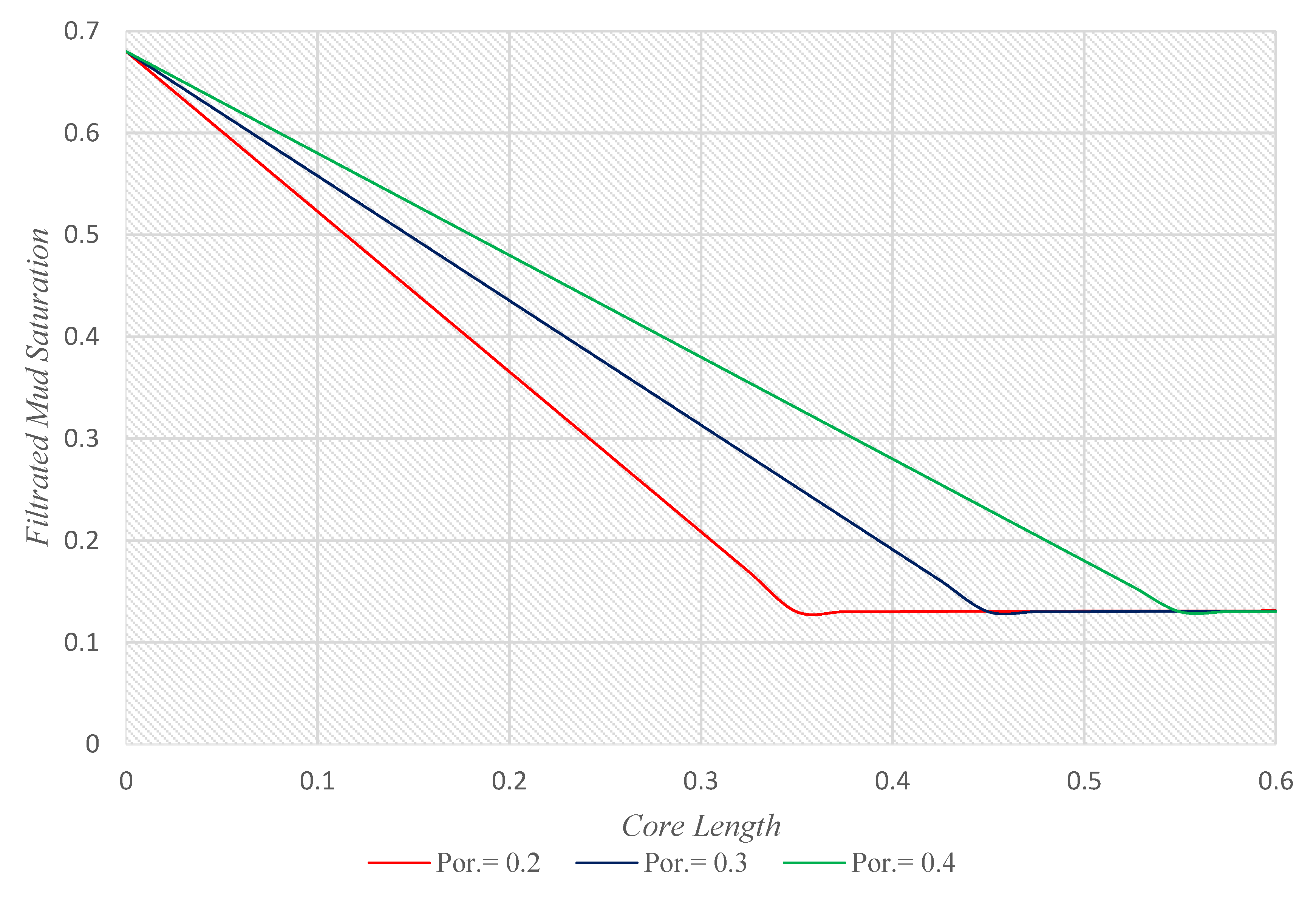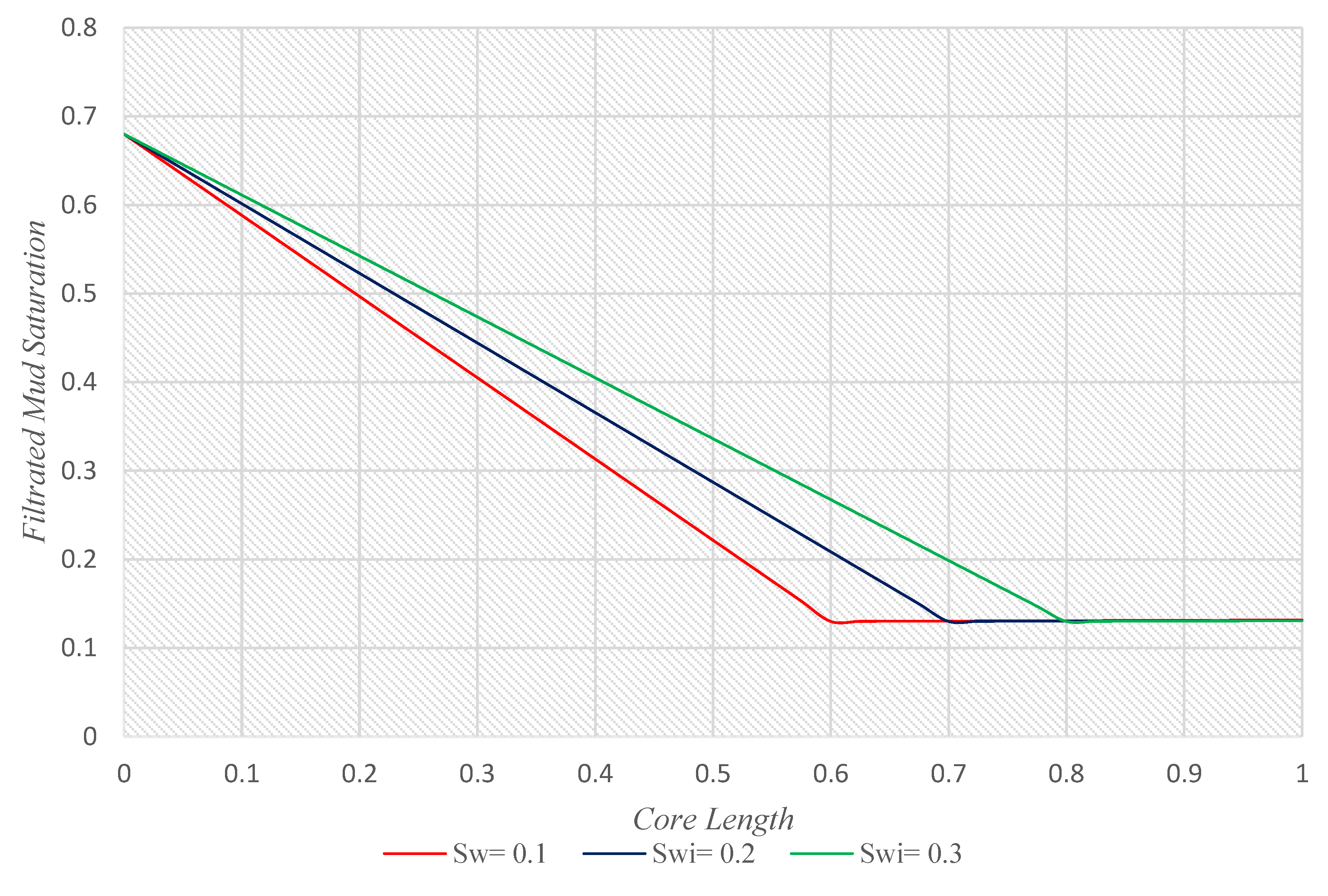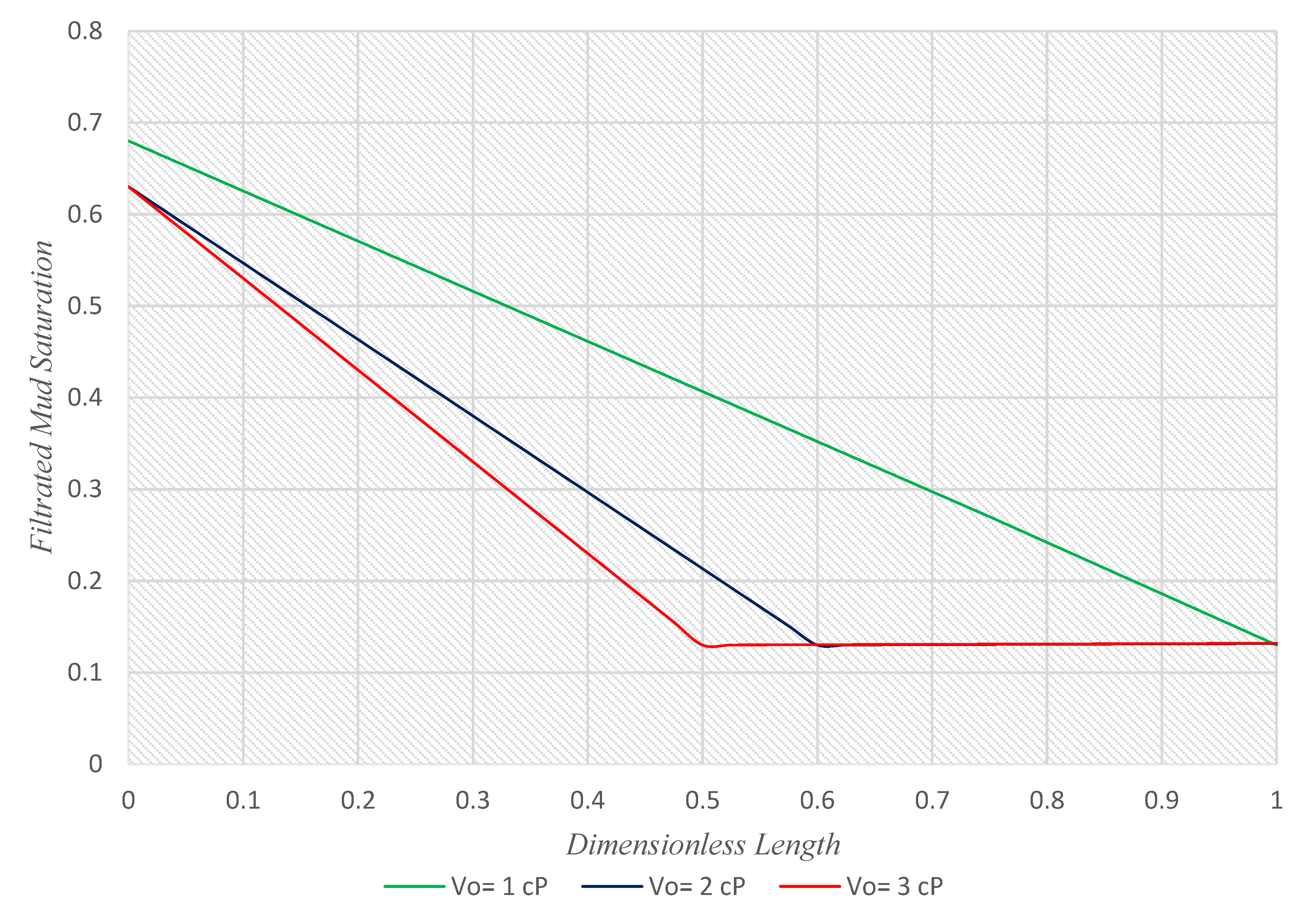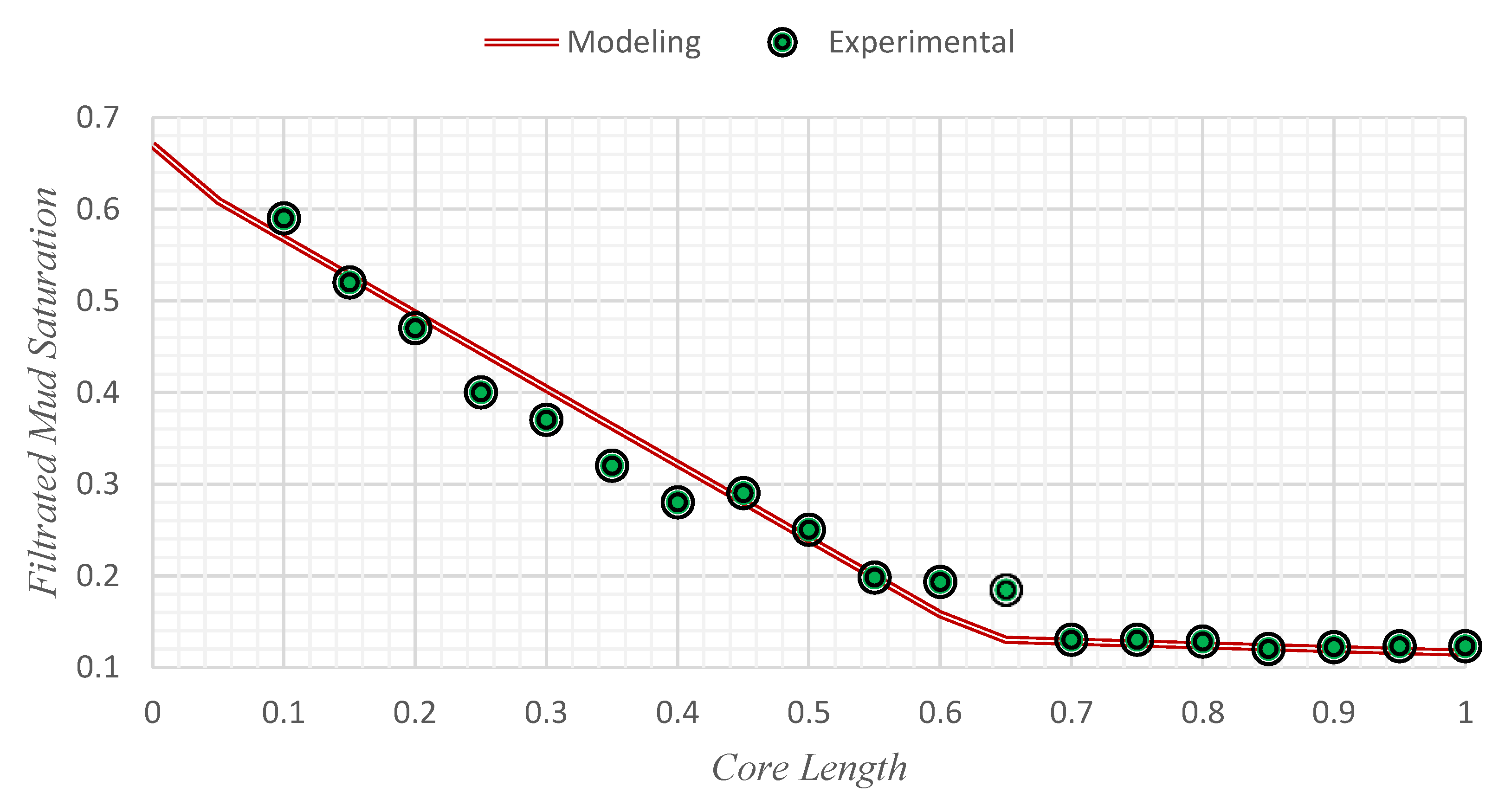Application of Implicit Pressure-Explicit Saturation Method to Predict Filtrated Mud Saturation Impact on the Hydrocarbon Reservoirs Formation Damage
Abstract
:1. Introduction
2. Methodology
Experimental Section
3. Results and Discussion
3.1. Porosity Effect
3.2. Permeability Effect
3.3. Water Saturation Effect
3.4. Oil Viscosity Effect
3.5. The Validity of the Proposed Model
4. Conclusions
Supplementary Materials
Author Contributions
Funding
Acknowledgments
Conflicts of Interest
Nomenclature
| Nomenclature | |
| B | Capillary pressure parameter |
| c | Coefficients of the penetration |
| Dm | Maximum value of the penetration coefficient |
| K | Absolute permeability |
| kr | Relative permeability |
| n | Coefficients of the penetration |
| P | Pressure |
| Pi | Formation initial pressure |
| S | Saturation |
| u | Velocity |
| Greek letters | |
| Porosity | |
| Tortuosity | |
| ρ | Density |
| φ | Cross-Section porosity |
| μ | Viscosity |
References
- Pedersen, T.; Godhavn, J.-M. Linear multivariable control of underbalanced-drilling operations. SPE Drill. Completion 2017, 32, 301–311. [Google Scholar] [CrossRef]
- Pedersen, T.; Aarsnes, U.J.F.; Godhavn, J.-M. Flow and pressure control of underbalanced drilling operations using NMPC. J. Process. Control. 2018, 68, 73–85. [Google Scholar] [CrossRef]
- Davarpanah, A.; Shirmohammadi, R.; Mirshekari, B.; Aslani, A. Analysis of hydraulic fracturing techniques: Hybrid fuzzy approaches. Arab. J. Geosci. 2019, 12, 402. [Google Scholar] [CrossRef]
- Davarpanah, A.; Mirshekari, B.; Behbahani, T.J.; Hemmati, M. Integrated production logging tools approach for convenient experimental individual layer permeability measurements in a multi-layered fractured reservoir. J. Pet. Technol. 2018, 8, 743–751. [Google Scholar] [CrossRef] [Green Version]
- Ojha, K.; Saxena, A.; Pathak, A. Underbalanced drilling and its advancements: An overview. J. Pet. Eng. Technol. 2019, 4, 37–51. [Google Scholar]
- Davarpanah, A.; Mirshekari, B. Mathematical modeling of injectivity damage with oil droplets in the waste produced water re-injection of the linear flow. Eur. Phys. J. Plus. 2019, 134, 180. [Google Scholar] [CrossRef]
- Davarpanah, A. The feasible visual laboratory investigation of formate fluids on the rheological properties of a shale formation. Environ. Sci. Technol. 2019, 16, 4783–4792. [Google Scholar] [CrossRef]
- Shi, H.; Song, H.; Zhao, H.; Chen, Z. Numerical Study of a Flow Field Near the Bit for a Coiled-Tubing Partial Underbalanced Drilling Method. J. Energy Resour. Technol. 2019, 141. [Google Scholar] [CrossRef]
- Davarpanah, A.; Mirshekari, B.; Razmjoo, A. A parametric study to numerically analyze the formation damage effect. Energy Explor. Exploit. 2020, 38, 555–568. [Google Scholar] [CrossRef]
- Li, X.; Ma, H.; Zhao, H.; Gao, D.; Lu, B.; Ding, S.; Gong, D.; Ma, Z. Study on the model for predicting maximum allowable measured depth of a horizontal well drilled with underbalanced operation. J. Pet. Sci. Eng. 2020, 191, 107104. [Google Scholar] [CrossRef]
- Davarpanah, A.; Mirshekari, B. Effect of formate fluids on the shale stabilization of shale layers. Energy Rep. 2019, 5, 987–992. [Google Scholar] [CrossRef]
- Mendes Sales, I.; Alexandre Martinello, I.; Couto Lemgruber Kropf, T.; Mesquita Caetano, L.; Alonso Fernandes, A.; Loures Sa, L. Wireline Logging in Managed Pressure Drilling Well on a DP Rig. In Proceedings of the IADC/SPE Managed Pressure Drilling and Underbalanced Operations Conference and Exhibition, Amsterdam, The Netherlands, 9–10 April 2019. [Google Scholar]
- Rabbani, E.; Davarpanah, A.; Memariani, M. An experimental study of acidizing operation performances on the wellbore productivity index enhancement. J. Pet. Technol. 2018, 8, 1243–1253. [Google Scholar] [CrossRef] [Green Version]
- Davarpanah, A. Feasible analysis of reusing flowback produced water in the operational performances of oil reservoirs. Environ. Sci. Pollut. Res. 2018, 25, 35387–35395. [Google Scholar] [CrossRef]
- Okwu, M.O.; Nwachukwu, A.N. A review of fuzzy logic applications in petroleum exploration, production and distribution operations. J. Pet. Explor. Prod. Technol. 2019, 9, 1555–1568. [Google Scholar] [CrossRef] [Green Version]
- Santos, H.; Queiroz, J. How effective is underbalanced drilling at preventing formation damage? In Proceedings of the SPE International Symposium on Formation Damage Control, Lafayette, LA, USA, 23–24 February 2000. [Google Scholar]
- Qutob, H. Underbalanced drilling; remedy for formation damage, lost circulation, & other related conventional drilling problems. In Proceedings of the Abu Dhabi International Conference and Exhibition, Abu Dhabi, UAE, 10–13 October 2004. [Google Scholar]
- Salehi, S.; Hareland, G.; Nygaard, R. Numerical simulations of wellbore stability in under-balanced-drilling wells. J. Pet. Sci. Eng. 2010, 72, 229–235. [Google Scholar] [CrossRef]
- Salimi, S.; Ghalambor, A.; Tronvoll, J.; Andersen, K.I. A Simple Analytical Approach to Simulate Underbalanced-drilling in Naturally Fractured Reservoirs—The Effect of Short Overbalanced Conditions and Time Effect. Energies 2010, 3, 1639–1653. [Google Scholar] [CrossRef] [Green Version]
- Xiao, B.; Wang, W.; Zhang, X.; Long, G.; Fan, J.; Chen, H.; Deng, L. A novel fractal solution for permeability and Kozeny-Carman constant of fibrous porous media made up of solid particles and porous fibers. Powder Technol. 2019, 349, 92–98. [Google Scholar] [CrossRef]
- Xiao, B.; Wang, S.; Wang, Y.; Jiang, G.; Zhang, Y.; Chen, H.; Liang, M.; Long, G.; Chen, X. Effective thermal conductivity of porous media with roughened surfaces by Fractal-Monte Carlo simulations. Fractals 2020, 28, 2050029. [Google Scholar] [CrossRef]
- Long, G.; Liu, S.; Xu, G.; Wong, S.W.; Chen, H.; Xiao, B. A Perforation-Erosion Model for Hydraulic-Fracturing Applications. SPE Prod. Oper. 2020, 33, 770–783. [Google Scholar] [CrossRef]
- Bennion, D.; Thomas, F. Underbalanced drilling of horizontal wells: Does it really eliminate formation damage? In Proceedings of the SPE Formation Damage Control Symposium, Lafayette, LA, USA, 7–10 February 1994. [Google Scholar]
- Byrne, M.; Patey, I. Formation Damage Laboratory Testing—A Discussion of Key Parameters, Pitfalls and Potential. In Proceedings of the SPE European Formation Damage Conference, Hague, The Netherlands, 13–14 May 2003; p. 9. [Google Scholar]
- Sedaghatzadeh, M.; Shahbazi, K.; Ghazanfari, M.H.; Zargar, G. The impact of nanoparticles geometry and particle size on formation damage induced by drilling nano-fluid during dynamic filtration. J. Nano Res. 2016, 43, 81–97. [Google Scholar] [CrossRef]
- Shi, H.-Z.; Ji, Z.-S.; Zhao, H.-Q.; Song, H.-Y.; Chen, Z.-L.J. Investigations into the coiled tubing partial underbalanced drilling (CT-PUBD) technique for drilling hard formations. Pet. Sci. 2018, 15, 830–840. [Google Scholar] [CrossRef] [Green Version]
- Ezeakacha, C.P.; Salehi, S.; Ghalambor, A.; Bi, H. Investigating Impact of Rock Type and Lithology on Mud Invasion and Formation Damage. In Proceedings of the SPE International Conference and Exhibition on Formation Damage Control, Lafayette, LA, USA, 7–9 February 2018; p. 15. [Google Scholar]
- Liu, W.; Zhou, Y.; Zhu, X.; Meng, X.; Liu, M.; Wahab, M.A. Numerical modelling of bottom-hole rock in underbalanced drilling using thermo-poroelastoplasticity model. Struct. Eng. Mech. 2019, 69, 537–545. [Google Scholar]
- Perrin, J.-C.; Benson, S. An experimental study on the influence of sub-core scale heterogeneities on CO2 distribution in reservoir rocks. Transport. Porous Media 2010, 82, 93–109. [Google Scholar] [CrossRef]
- Akin, S.; Kovscek, A. Imbibition studies of low-permeability porous media. In Proceedings of the SPE Western Regional Meeting, Anchorage, AL, USA, 26–27 May 1999. [Google Scholar]
- Khakshour, M. Experimental Investigation of Formation Damage in UBD. Master’s Thesis, Petroleum University of Technology, Ahwaz, Iran, 2010. [Google Scholar]
- Zhang, J. Effects of porosity and permeability on invasion depth during drilling mud-filtrate invading into a reservoir dynamically. In Proceedings of the 7th International Conference on Education, Management, Information and Mechanical Engineering (EMIM 2017), Shenyang, China, 28–30 April 2017; Atlantis Press: Paris, France, 2017. [Google Scholar]
- Costa, A. Permeability-porosity relationship: A reexamination of the Kozeny-Carman equation based on a fractal pore-space geometry assumption. Geophys. Res. Lett. 2006, 33. [Google Scholar] [CrossRef]





| Parameter | Value | Unit |
|---|---|---|
| 3 | Psi | |
| 2 | Dimensionless | |
| 2 | Dimensionless | |
| 0.1 | Dimensionless | |
| 0.7 | Dimensionless | |
| 0.15 | Dimensionless | |
| Oil Viscosity | 1.6 | cP |
| Mud Viscosity | 0.86 | cP |
| Absolute Permeability | 2.75 | mD |
© 2020 by the authors. Licensee MDPI, Basel, Switzerland. This article is an open access article distributed under the terms and conditions of the Creative Commons Attribution (CC BY) license (http://creativecommons.org/licenses/by/4.0/).
Share and Cite
Zhu, M.; Yu, L.; Zhang, X.; Davarpanah, A. Application of Implicit Pressure-Explicit Saturation Method to Predict Filtrated Mud Saturation Impact on the Hydrocarbon Reservoirs Formation Damage. Mathematics 2020, 8, 1057. https://doi.org/10.3390/math8071057
Zhu M, Yu L, Zhang X, Davarpanah A. Application of Implicit Pressure-Explicit Saturation Method to Predict Filtrated Mud Saturation Impact on the Hydrocarbon Reservoirs Formation Damage. Mathematics. 2020; 8(7):1057. https://doi.org/10.3390/math8071057
Chicago/Turabian StyleZhu, Mingxuan, Li Yu, Xiong Zhang, and Afshin Davarpanah. 2020. "Application of Implicit Pressure-Explicit Saturation Method to Predict Filtrated Mud Saturation Impact on the Hydrocarbon Reservoirs Formation Damage" Mathematics 8, no. 7: 1057. https://doi.org/10.3390/math8071057





